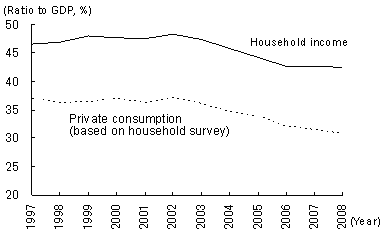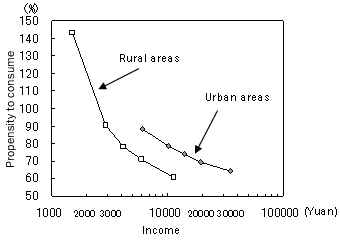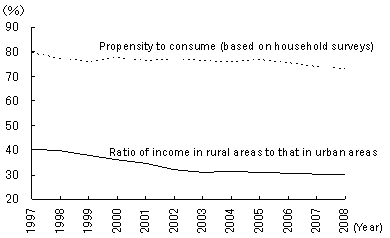Factors for sluggish consumption
In recent years, private consumption in China as a percentage of gross domestic product (GDP) has declined to only 30.8% in 2008 (based on household surveys, which is slightly lower than 35.3% based on GDP). The ratio of private consumption to GDP can be broken down to the ratio of household income to GDP and the propensity to consume (the percentage of private consumption to household income) ( note ). In China, both components have been following a downward trend, and this has become a cause of the sluggish growth in consumption.
To begin with, reflecting that the income distribution of GDP has been tilted more heavily to government and corporations than it has been to households, the ratio of household income to GDP and, by extension, the ratio of private consumption to GDP has been declining ( figure 1 ). Although many monopolistic state-owned enterprises, in particular, make large profits, most of the earnings are kept in the corporate sector as retained earnings for use in investment, rather than distributed as dividends to the state (the government), their owner, thereby crowding out private consumption.
Figure 1: Household income vs. private consumption

(Note) Private consumption data do not necessarily match the GDP-based figure, as private consumption data are calculated by per capita consumption of households.
(Source) Prepared based on annual editions of China Statistics Abstract
Meanwhile, the propensity to consume is influenced by the distribution of income, in addition to the level of development of the social security system and the age structure of the population. More specifically, the propensity to consume is inversely proportional to the income level and tends to be lower in the high-income population and higher in the low-income group. Widening the income disparity means that income will increasingly concentrate on the high-income population with a low propensity to consume, and this will become a factor in lowering the overall propensity to consume.
The income disparity has continued to expand in China. The difference in per capita income between urban and rural areas widened from 2.8 times in 2000 to 3.3 times in 2008. There is also a noticeable concentration of income in certain populations, even within urban and rural areas. If we divide all urban households equally into five groups by income, the gap in household income between the top 20% group and the bottom 20% group widened from 3.6 times in 2000 to 5.7 times in 2008. In rural areas, the gap between the two groups grew from 6.5 times in 2000 to 7.5 times in 2008.
In China, too, the propensity to consume tends to be lower in the high-income population and higher in the low-income group. First, reflecting the fact that income in rural areas is lower than it is in urban areas, the propensity to consume was 76.9% in rural areas in 2008, compared with 71.2% in urban areas (results based on 2008 figures). Looking at the aforementioned five income groups in the household sector, the propensity to consume is highest in the lowest income group and declines in the order of middle lower, middle, middle upper and upper groups ( figure 2 ). In urban areas, for example, it is high at 88.5% in the lowest 20% group and falls to 64.3% in the top 20% group (results based on 2008 survey).
Figure 2: Propensity to consume inversely proportional to the income level (2008)

(Note) Five income groups in urban and rural areas in order of household income (Each of the upper, middle upper, middle, middle lower, and lowest groups account for 20% of the number of households in both urban and rural areas).
(Source) Prepared based on China Statistics Abstract 2009
As described above, the widening income disparity is lowering the overall propensity to consume and limits consumption growth. In fact, the propensity to consume has declined along with the fall in the ratio of per capita income in rural areas compared to urban areas (widening income gap) ( figure 3)
Figure 3: Propensity to consume vs. income disparity between urban and rural areas

(Note) Private consumption data do not necessarily conform to the GDP-based figure, as private consumption data is calculated by per capita household consumption.
(Source) Prepared based on annual editions of China Statistics Abstract
Measures to boost consumption
Marx argues that, in capitalist nations, workers are exploited and incomes do not increase in line with production, which leads to overproduction and eventually to economic crises. Ironically, this analysis seems to apply more to China, which claims to be a socialist country, than it does to the capitalistic United States, which suffers from excessive consumption.
Despite the lack of domestic demand caused by sluggish consumption, China has sustained high growth by exporting output in excess of domestic demand to overseas markets including the United States. However, with the United States now having to reduce consumption and, by extension imports, following the financial crisis, China must boost domestic demand centering on consumption if it is to sustain its impressive growth.
To do that, China will need to raise its propensity to consume by correcting the income disparity between urban and rural areas as well as between the high-income and low-income groups, while redistributing income from the government and corporate sectors to the household sector. According to the five income groups in urban areas cited above, if income of 100 yuan is transferred from the top 20% group to the bottom 20% group, overall consumption will increase by 24.2 yuan as the consumption of the latter will increase 88.5 yuan, while that of the former will decrease 64.3 yuan. As a result, the overall propensity to consume will also rise.
However, this conclusion is based on the tacit assumption that overall income will not change (or will change little) even if an income redistribution policy such as progressive taxation is adopted. Nevertheless, as experienced by many countries, including China, before shifting to policies of reform and openness, an excessive income redistribution policy could reduce the willingness of entrepreneurs to invest and the incentive of workers to work, which in turn could produce economic stagnation. If this happens, overall consumption could decrease even if the propensity to consume rises because overall income will decline. Therefore, when drawing up an income redistribution policy, it is necessary to take into account the impact on both demand and supply, in addition to striking a balance between fairness and efficiency.



